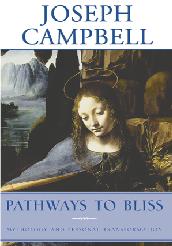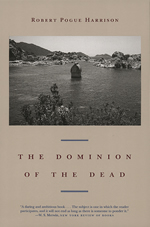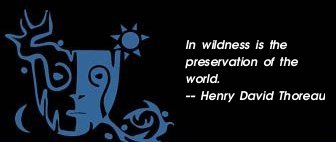
Book Reviews
by Dennis Patrick Slattery

Dennis Patrick Slattery, Ph.D. is Core Faculty, Mythological Studies, Pacifica Graduate Institute.
He is the author of over 225 articles on culture, psychology and literature, as well as author of 7 books. His most
recent is entitled Grace in the Desert: Awakening to the Gifts of Monastic Life (Jossey — Bass, 2004), a
spiritual pilgrimage staying in 12 monasteries and Zen Buddhist centers in the United States over a 3 and a half
month sojourn. Dr. Slattery was also a presenter at the 2004 Mythic Journeys Conference.
Joseph Campbell
Pathways to Bliss: Mythology and Personal Transformation.
Novato, California: New World Library, 2004
$20.00 cloth. 194pp.

Joseph Campbell repeats himself often. However, as I continue to ripen on the vines of life, I find that
repetition is not only beneficial, but also a constant in psyche's pattern: to return repeatedly to a notion, an idea, an image,
and to entertain it once more. I do not want to say from the above, that there is nothing new under the covers of this most
recent book from the Joseph Campbell Foundation. Campbell is always working a fresh side of a familiar idea, adding to it
as he reconsiders its options.
Divided into four parts, the book covers old ground in new ways: Part 1: Man and Myth; Part 2: Living Myth;
Part 3: The Hero's Journey; Part 4: Dialogues. In these four angles on mythic thinking, Campbell riffs anew on the slippery
tunes of myth, literature, philosophy, eastern mysticism, western philosophy and in this sense creates a universe parallel to
Jung's, who saw the psyche with a thousand faces in his own collected works and struggled to give them form.
Campbell's book here, however, walks right on the white chalk line between a "self-help" book, a mystical
treatise and a cultural biography. The still center of his argument here, as one sees in the title, is the word "bliss," which
has received culturally over the years bumper sticker immortality. Campbell tracks the word from the Taittiriya Upanishad,
which speaks of the five sheaths that enclose the atmas, the spiritual ground or germ of the individual: The sheaths
of food, breath, mental state, wisdom and Bliss, which last sheath he believes is a "kernel of that transcendence in and of itself"
(p. xxi). To move into this bliss sheath is to enter a realm "that contains all opposites" (p. xxi).
Guided once more by the scholar of Indian mythology, Heinrich Zimmer, and the anthropologist Adolf Bastian,
Campbell returns to the fundamental properties of myths shared around the world, as his scholarship revealed to him: 1. to
reconcile consciousness to the preconditions of its own existence; 2. to present an image of the cosmos...that will maintain
and elicit the experience of awe; 3. to validate and maintain a certain sociological system, a shared set of rights and wrongs;
4. to carry the individual through the stages of life from birth through maturity through senility to death (pp. 5-8). These are
crucial touchstones for Campbell and he has built an edifice of mythological understanding with these stones.
In "Myth Through Time," Campbell asserts that the "imagery of myth is a language, a lingua franca, that
expresses something basic about our deepest humanity...which is then variously inflected in various provinces" (p. 22).
This verb "inflected" is part of Campbell's lexicon that comprises the other side of his often-attacked and discredited notion of a
"monomyth." What is left out of the attack is this second part: that the monomyth, which is the big idea, or in the language of
Adolf Bastian, the Elementargedanke, or elementary idea, finds its local habitation in the Volkergedanke, or ethnic idea (p.22).
Myth, it would seem, traverses between and gives expression to the former through concrete images and expressions of the
latter. These two together constitute the mythic landscape.
That same landscape is incarnated and made vital through ritual, which Campbell believes is the overt language
of myth. "A rite or ritual is an opportunity to participate directly in a myth; ... (by) participating in the rite, you participate in the myth"
(p. 31). Rites are repetitive acts by which a myth is kept alive in an individual and in a culture. His difficulty with religious dogmas,
as spin-offs of the above idea on rituals, is that they freeze the ritual and paralyze the myth of which it is an expression. The myth,
he senses, then dies of dehydration. Its loss of life is the direct consequence of emptying the symbols that the rites embody, of
their original psychic and spiritual energy. If a religious institution says to its people, he claims, "here is the way to respond to the
symbol, the only way," and the individual says to herself: "I don't feel that way, so am I a sinner?" (p 43). Then the individual who
is now outside the ritual is also outside the myth. From other of his writings we know that such an experience led Campbell himself
to leave the Catholic church.
He later in the book returns to this central vexation of his, the loss of the vitality of the religious symbol, which he
treats in greater depth in Thou Art That: Transforming Religious Metaphor. Its importance is underscored when he writes
that when religious symbols are no longer effective, "we lose the vehicle for communication between our waking consciousness
and our deepest spiritual life" (p.94). The path to discovering one's personal myth, he asserts, is by way of "determining those
traditional symbols that speak to you and use them as bases for mediation" (p.97). The often frightening decision to set out on one's
own, outside the compound of accepting traditional symbols' meanings, is at the heart of the Hero's journey, the controversial yet
essential plot that put Campbell forever on the map of mythic awareness.
I believe this and his other writings on the nature of the symbol and the health of a culture are more than relevant for
psychologists, clergy and any person interested in the vitality of values.

The Dominion of the Dead
By Robert Pogue Harrison
Chicago: University of Chicago Press, 2003
$23.00 cloth. 208pp.
Many books have been written on death and dying, some of them quite perceptive, as with Ernst Becker's classic,
The Denial of Death or A. Alvarez's The Savage God, on suicide. Jenny Yates has also given us Jung on Death
and Immortality in the finely-conceived Encountering Jung series. But rare is it that someone writes not about death but
about the dead and our living relation with them. Robert Pogue Harrison's tour de force on the dead is a profound meditation on
some fundamental rituals: why do we bury people when they die? What is so important about maintaining relations between the
living and the dead? What pulls almost every culture's mythology in the world toward the dead? More pointedly, what is it in the
Christian myth, which Harrison focuses on in part of his meditations, that makes Christ's death and resurrection something unique
historically and spiritually that shifted this complex and mysterious relationship between our progenitors and those who will live after us?
His chapter titles are alluring in their evocation: "The Earth and its Dead"; "What is a House?"; "The Voice of Grief";
"The Origin of Our Basic Words"; "Hic Non Est"; "The Afterlife of the Image," to name a few. In the words we use, in the references
we make, in the memories of our personal relationships with folks now past, and in our values and ideals, we, the living, are continually
communing and communicating with the dead, who, paradoxically, are often more alive in their passing than they were in their living
embodied presence. Indeed, as Harrison points out early in his book, having acknowledged an enormous debt to the work of Giambatista
Vico's The New Science (1744), our "humanity" is directly connected to "humando," burying. "Humus" means of the earth, and is
etymologically connected with "humility" (p. xi). His foundational argument is that humans bury their dead not just to separate from the
dead, but "above all to humanize the ground on which they build their worlds and found their histories" (p.x). The dead, then, are the
basis for the livings' impulse to civilize, to build, to dwell and to speak.
The earth herself is a prime illustration of the intimate relation between the living and the dead, for it, as Harrison observes,
is always absorbing its dead elements in order to create new life. We, like the earth, possess a humic foundation which is in fact the basis
and ground of the life world. Life needs the dead in order to build and develop. Denying the dead is tantamount to denying the life principle
itself. Thus, to acknowledge, face, and then to ritualize the burying of the dead gives them an afterlife, situates them in our personal or
collective memories, and allows us to form from their passing a future for ourselves.
I would offer, based on Harrison's astute observations, that mythology's creation may grow directly from a contemplative
response to the dead, along with a desire to give them a habitation in the land of the living. Further, this relation to the dead may also be
the foundational impulse of all religions.
In the chapter "Hic Non Est" (He is not here), Harrison meditates on the empty tomb of Christ and the angel's assertion that
Christ is no longer dead. In this act, Harrison believes, Christianity "expanded and altered the medium of relation between a living person
and a dead soul" (p. 106). Further, he claims, with "prayer and intercession of saints, the living may influence the fate of the dead" (p.107).
Conversely, the power of the resurrection within Christianity "rendered the souls of the living and those of the dead continuous in a new
way, as if the living soul were in some sense already dead, while the dead soul, in that same sense, were still alive" (p. 107). I would inject
parenthetically, that the above assertion is at the heart of, or pulse beat, of Dante's Commedia and serves, for me, as the best
representative of the Christian imagination's reflection on the marriage of the living and the dead.
In a fine discussion of the empty tomb, Harrison believes the gospels converge on one truth: "what the women and disciples
do not see when they look inside the tomb — Jesus' dead body" (p. 109). The empty tomb Harrison conjectures "is full of promise of
things unseen" (p. 109), which certainly recalls the words of St. Paul: "faith is the substance of things hoped for, the evidence of things
unseen" (p.110). The empty tomb comprises "a sepulchral promise: the tomb full of meaning in its emptiness."
Perhaps, following on Harrison's argument, we could say that the Christian mystery is the most fully expressed foundational
witness to the principle of animation, of reanimation, of the dead among the living. When we read the scriptures, for example, we engage in
what Harrison calls "lexification," which "binds the generations, institutionalizes authority, and historicizes the law of legacy: it grounds human
historicity as such." To meditate on scripture is to commune with the dead in a living and vibrant way.
Another strong influence on this work is Martin Heidegger, who Harrison alternately praises and critiques, both in Heidegger's
excellent work on dwelling and on language. I find intriguing his reflections on the origin and place of words in our lives: "the moment a word
begins to mean something, it already has a past. We speak with the words of the dead" (p. 72). Words themselves, he believes, contain
"humic underworlds, where the dead hold sway over the very means of speech" ( p.76). Even uttering the words of the dead is to invite
"their spiritual presence back into our souls" (p.75). I especially appreciated Harrison's range of poets he uses to draw out the implications
of language: Giacomo Leopardi, Wallace Stevens, Shakespeare, Petrarch. The staple voice remains, however, Vico's, especially in his
exploration of the word lex and its relation to legere, reading. The latter word is etymologically rooted to "gathering, binding,
relating and collecting" (p.79). Speaking is a form of gathering, of collecting, even collating thoughts and spirits of the past, making them
alive again to give our own future some clarity if not direction. I think here of the many possibilities within therapy, teaching, reading and
writing that Harrison's provocative musings generate.
His study is powerful, penetrating, fresh and profound. From so many angles of insight, Harrison convinces the reader that
we the living cannot navigate through this life without mortal or divine assistance from the dead. Our mortal coil needs an active recoil from
the dead. Towards the end of his study, he makes this remarkable assertion: "The dead are our guardians; we give them a future so that
they may give us a past. We help them live on so that they may help us go forward" (p. 158). The dead emerge from out of the darkness
as one of our most powerful tribes of guides for the living. Without them we may live a life in bewilderment, never fully dwelling in the present
because of having eschewed the past.
Finally, his copious notes at the end, as well as a generous and far-reaching bibliography, make this book a critical addition
to the study of humanities.
|
